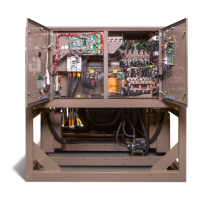JOHNSON CONTROLS
166
SECTION 9 - MAINTENANCE
Form 201.47-ICOM1
Issue date: 17/11/2022
Gauge Absolute
Boiling temperatures
of water, ⁰F
Inches of mercury
(Hg) below one
standard atmosphere
psia Millimeters of
mercury (Hg)
Microns
0 in. 14.6960 760.00 760,000 212
10.240 in. 9.6290 500.00 500,000 192
22.050 in. 3.8650 200.00 200,000 151
25.980 in. 1.9350 100.00 100,000 124
27.950 in. 0.9680 50.00 50,000 101
28.940 in. 0.4810 25.00 25,000 78
29.530 in. 0.1920 10.00 10,000 52
29.670 in. 0.1220 6.30 6,300 40
29.720 in. 0.0990 5.00 5,000 35
29.842 in. 0.0390 2.00 2,000 15
29.882 in. 0.0190 1.00 1,000 1
29.901 in. 0.0100 0.50 500 –11
29.917 in. 0.0020 0.10 100 –38
29.919 in. 0.0010 0.05 50 –50
29.9206 in. 0.0002 0.01 10 –70
29.921 in. 0 0 0
Note:
• One standard atmosphere = 14.696 psia = 760 mm Hg absolute pressure at 32°F = 29.921 in. Hg absolute at 32°F
• psig = pound per square inch gauge pressure = pressure above atmosphere
• psia = pound per square inch absolute pressure = sum of gauge plus atmospheric pressure
• Shell volume = L*π * r2= (Length in feet)*( 3.1416)*(radius squared) = cubic feet
To keep the units consistent, round the length and radius to the nearest tenth of a foot.
• μm = Micron
Table 28 - System pressures
Dehydration
To make sure that there is confidence in the vacuum
decay related to moisture boiling off, only perform the
dehydration process after the system has been thor-
oughly leak checked. The dehydration process is only
needed if the following occurs:
1. The nitrogen holding charge on shipments has
been lost.
2. The system has been open to the atmosphere for
any length of time.
3. Tube leaks have introduced moisture to the refrig-
erant circuit.
4. Indications of moisture contamination have ap-
peared in any of the sight glasses Dehydration of
a refrigerant system can be obtained by the evacu-
ation method because the water present in the
system reacts much as a refrigerant would. How-
ever, the vacuum pressure in the system cannot
always be pulled down to a point where its satura-
tion temperature is considerably below that of the
equipment room temperature due to low ambient
room conditions and other factors. As a result, you
warm water through at least one vessel to raise
the vessel internal temperature. This ensures that
the water, so that a large percentage of it can be
removed by the vacuum pump.
The length of time necessary for the dehydration of a
system depends on the size or volume of the system,

